|
Monday, June 20, 2011
Progress Notes
Recently we were visited by Jerrylynn Bergfeld of the St. Louis area who is a granddaughter of Lawrence Wright of Tuscumbia, the very well known journalist who was publisher and editor of the Miller County Autogram during the early part of the last century (photos 01 and 02).
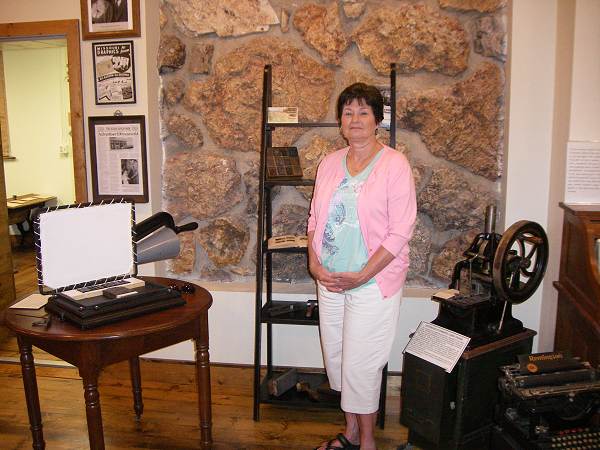
01 Jerrilynn Bergfeld
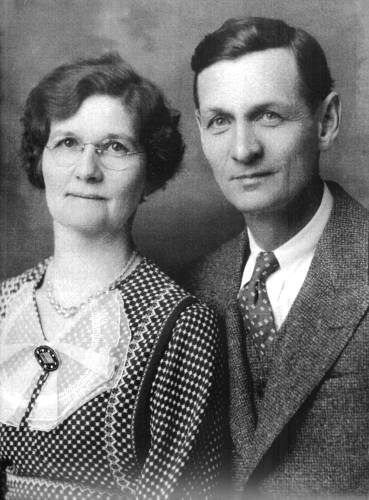
02 Lawrence Alfred and Carmen Ercel Bassman Wright
Jerrylynn’s purpose in coming to see us was to donate many of Lawrence’s old diaries, account ledgers, old newspapers and other memorabilia of his life and career. Jerrylynn was not raised in Tuscumbia but her father, Gerald Wright, son of Lawrence, was a native having gone to school here. Many people will remember the stone house located just across the street from the school where Lawrence and his family lived. We are very grateful to Jerrylynn for bringing us these very important historical memorabilia and documents possessed by her grandfather, Lawrence Wright.
The Autogram is the oldest newspaper in Miller County according to a history of the paper written by Lawrence Wright published in the Autogram in 1928. Copied below is that article:
The Miller County Autogram
March 15, 1928
The Miller County Autogram Is 45 Years Old This Month
Established At Aurora Springs In 1883 by Marcy and McBride; McBride Later Bought Marcy’s Interest and Moved Office to Tuscumbia.
The Miller County Autogram has rounded out forty five years of its journalistic career. Number 1 of Volume 1 was issued at Aurora Springs by Marcy & McBride in March 1883, but they continued as partners a very short time. In fact, a few months later, Mr. McBride bought out Mr. Marcy and the Autogram was then moved to Tuscumbia, where it has apparently made its permanent home.
About the year 1910 Mr. McBride sold the paper to W.E. Martin and W.M. Bear and they continued the paper for several years. In 1911 Mr. Martin leased his half interest for one year to L.A. Wright, and he and W. M. Bear continued its publication for the following year. Mr. Martin then came into the office again, later buying Mr. Bear’s interest. Some time later, E. P. Clark bought a half interest in the paper and then in 1919 the plant was bought by the present owners, W.S. Stillwell and L. A. Wright (photos 03, 04 and 05).
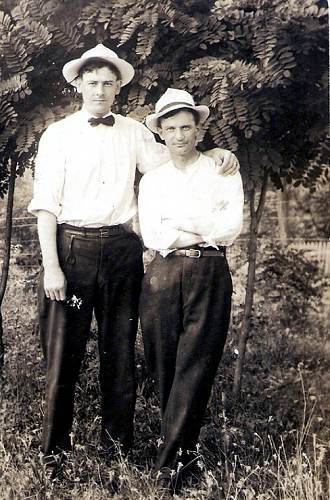
03 Will Bear and Ed Clark
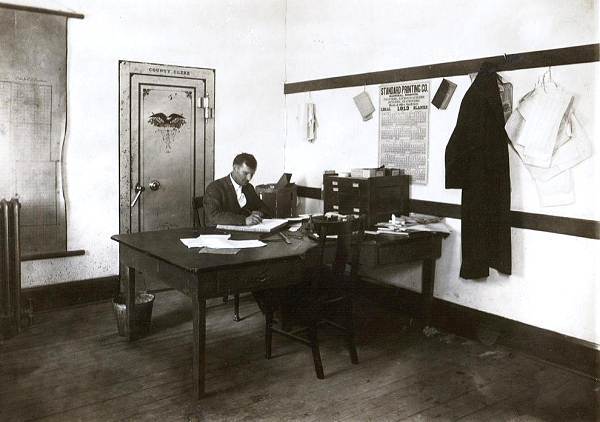
04 Edward P. Clark - 1913
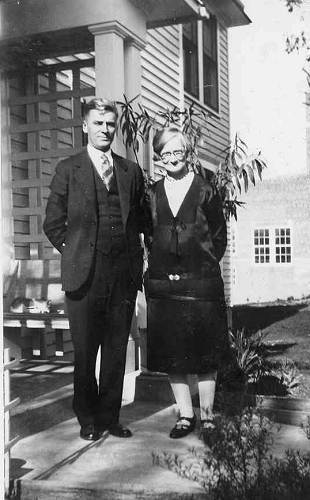
05 Walter and Lydia Fendorf Stillwell
In connection with the newspaper business at Tuscumbia it might be of interest to our readers to tell something about the other papers that Tuscumbia has had, in view of the fact that there have been many, and that Tuscumbia had the first newspaper in the county.
The Osage Valley Sentinel published by Lemmon & Hitchcock, is said to have been the first newspaper published in Tuscumbia and in the county. It was published here from about 1871 to 1875 and then moved to Richland. During 1871, also, M. W. Gustin started the Republican, with which he soon after joined the Sun, another paper of his elsewhere under the title of Sun and Republican. In the fall of 1872 it was bought by Judge I.M. Goodrich, and one printing outfit was sold to Linn Creek parties, and the other plant was sold to J.H.D. Tomson and J. P. Wright who stared a religious monthly called the Gospel Proclamation (photos 06 and 07).
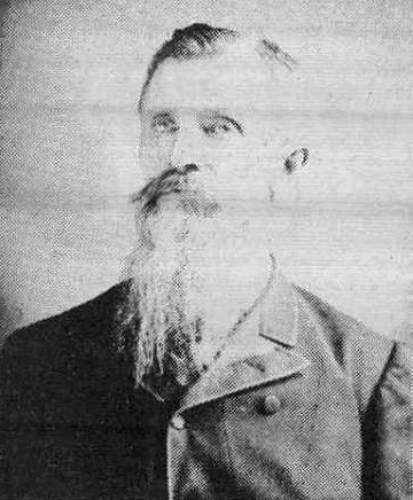
06 Reverend Josiah Henry Dockery Thompson
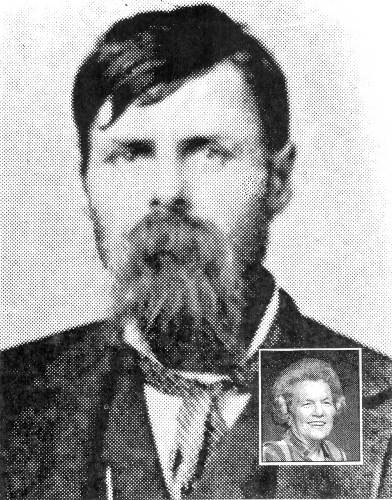
07 James Pinkney Wright
Meanwhile about 1872 the Miller County Vidette began as a Republican paper. Editor R. Goodrich bought it and sold it to Linn Creek parties.
About this time the Gospel Proclamation was changed to a weekly paper called the Vindicator and about a year later J.P. Wright assumed control. Mr. Wright later published the Eye-Opener which he continued at Tuscumbia until about the year 1898 when the paper and plant were bought by Warren M. Barr of Vienna, and the name of the paper was then discontinued after Mr. Barr operated it for some six or eight years.
In 1876 the Helmet, by L.S. Hitchcock, began as a Republican sheet, but successively fell into the hands of Abe Fulkerson, I.M. Goodrich and F.A. Goodrich, who ran it a few months as the Miller County Republican and turned it over to the Vindicator (photo 08).
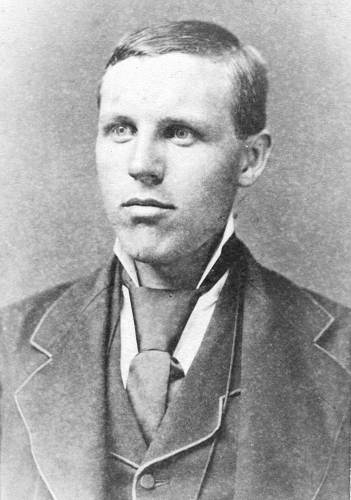
08 F.A. Goodrich
Another newspaper which was published at Tuscumbia was the Miller County Republican, published by H.W. Scott and O. W. Wright for two or three years (photo 09).
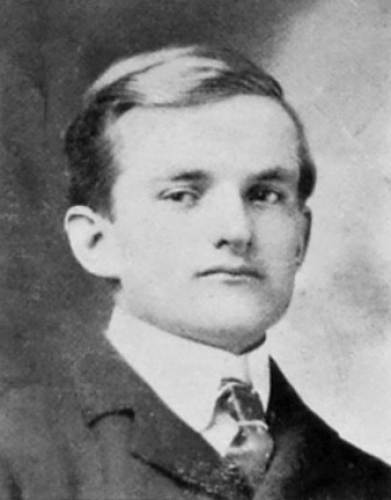
09 Otis W. Wright
The Autogram is now the oldest newspaper in the county, having been published continuously for a period of 45 years. It began as a small weekly printed on a Washington hand press; then about the year 1895 the office began “stepping out” by buying a Prouty cylinder press which continued to disseminate the county news until the present large press was installed. The circulation of the paper has grown from some 400 or 500 in the early years of its existence to more than 2400 at the present time. A copy of practically every issue of The Autogram is now in possession of the office.
The papers and other historical items donated by Ms. Bergfeld is the second major gift to the museum by members of Lawrence Wright’s family. Last year, Robert Clemens, another grandchild of Lawrence’s, donated to the museum a very rare portable printing press used by Lawrence’s father, James Pinkney Wright, as well as other papers and articles belonging to Lawrence. You can review that story at this previous Progress Notes.
These next photos are of printing press paraphernalia donated by the Wright family to our museum (photos 10, 11 and 12):
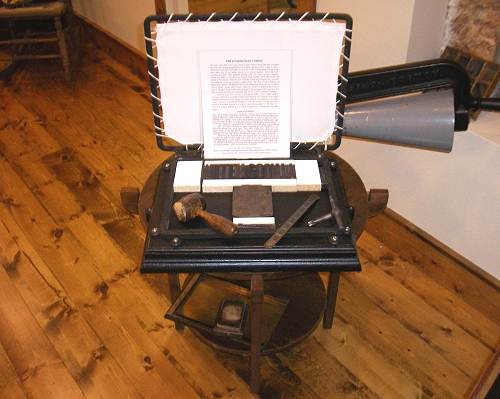
10 James Pinkney Wright Press
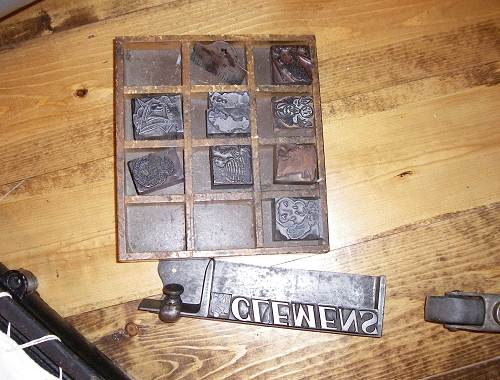
11 Dies and Layout Tools
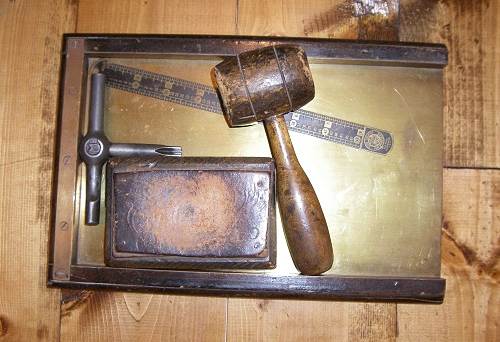
12 Layout Tray and Pica Ruler
One particularly interesting antique press owned by Walter Stillwell and Lawrence Wright was a card press called the Superior Automatic Card Press (photo 12a).
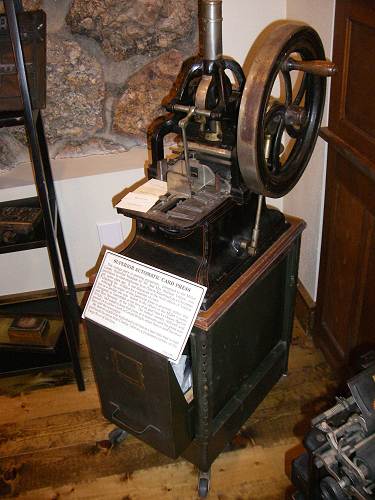
12a Superior Automatic Card Press
Years after Stillwell and Wright owned the press it was bought by employees of the Vernon Publishing Company as a gift for Mr. and Mrs. Wallace Vernon, who later donated it to our museum.
Here is a photo of the cover page of the 1911 Holiday edition of the Autogram when William Bear was a co owner with Lawrence Wright of the Autogram (photo 13):
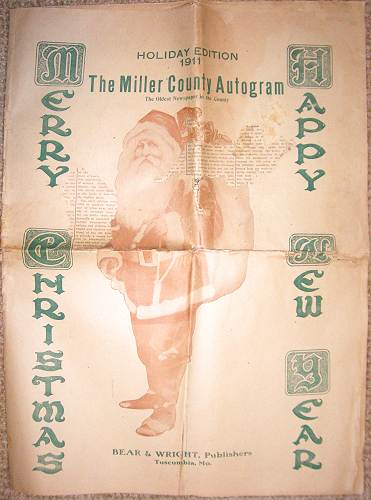
13 Autogram Holiday Edition - 1911
William Bear was a nephew of my great grandfather, David Christian Bear.
Once in a while I come across an old article in the Advertiser or Autogram that I think merits presenting to the readers of this website because of more than usual historical interest. That is the case I think with this next essay. It was published in the Eldon Advertiser in 1935 in three consecutive editions of the paper because it is quite long. Also, it had no photos accompanying it. However, I thought it so interesting that I decided to put it on our website because the author, Anna Garrison Posten, so vividly describes Miller County pioneer life in the mid 19th century. The story is that of the Albert Charles Foote family which came to Miller County from Ohio in 1867 and settled on a farm a couple or three miles southwest of Eldon. The only Foote family descendent I found in the area was Roberta Hoskins of near Barnett. She said at one time she had a photo of her great grandfather, Charles Foote but could not find it at the time of this week’s Progress Notes. On a plat map of 1905 the farm was located in T41N R15W at the northern edge of section 6 (photos 14 and 15).
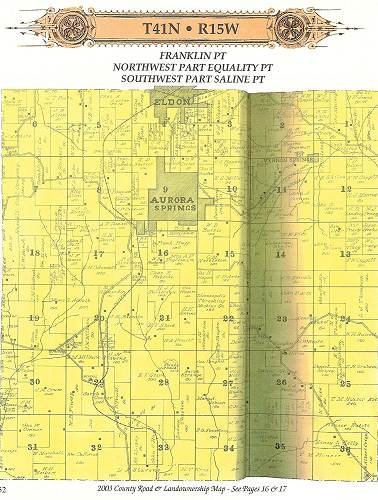
14 T41N - R15W
Click image for larger view
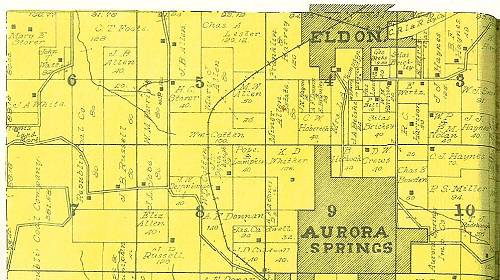
15 C.T. Foote - Section 6
Click image for larger view
For those readers who are interested in knowing more about the hardships and challenging life situations imposed upon our early settlers the following articles will be of interest:
Eldon Advertiser
July 25, 1935
Looking Back Over 86 Years Living In Missouri Ozarks
By Anna Garrison Posten
Sixty eight years on the same farm is the unusual record held by Charley Foote who lives on the old Foote place two and one half miles southwest of Eldon, Missouri. In 1867 Charley’s parents, Albert Charles Foote and Mary Wells Foote, and their four children left their home near Croton, Ohio, and started to Miller County, Missouri. They crossed the Mississippi by ferry as there were no bridges spanning the river then, and from St. Louis they went to California, Missouri, on the Missouri Pacific railway. California at that time consisted of only two or three houses south of the railroad tracks, but the Foote family’s destination was a farm some twenty miles to the south in a new and undeveloped country. Albert Foote had a short time before bought the farm of two hundred acres, and had then returned to Ohio for his family. On March first, 1867 they reached their new home after driving from California in a lumber wagon drawn by a team of horses over a road that was often hub deep in mud. The new home was a log house containing two rooms but without a door opening from one room to the other. Mr. Foote inquired the reason for this.
“Well,” said Bill Nolan, strapping son of the widow from whom Mr. Foote had bought the land, “it was built that way so the Indians couldn’t get from one room to the other and the white folks had a little better chance to defend themselves.”
The house standing on a slope near a spring had been built in the open so as to give the settlers a chance to get water from the spring and return to the house before the Indians could reach them from the surrounding timber. The days of Indian warfare were over when the Foote family arrived but they faced other dangers and hardships of which present residents can form scarcely any realization. The old log house was the first house built in that part of the county. Many years ago it was taken away to serve as an exhibit in the Omaha Exhibition where it was occupied by an Old Miller County Negro, Abe Flood. The spring still flows through a grassy slope not far from a tangle of vines and brush that cover the ruins of the crumbled fireplace.
The fireplace was an important feature in the pioneer home of the Foote family. There were but few cook stoves in use then and the cooking was done in the fireplace, some women cooked outdoors in the summer over fires made like a campfire on the open ground. Besides being used for cooking, the fireplace supplied much of the light. There was a small square window in each room and more light came through open chinks between the logs in the walls. Artificial light was furnished by grease lights as there were no lamps. Grease lights were made by pouring any kind of grease in a shallow pan or dish and laying a strip of cloth in the grease and over the edge of the pan. The outer end of the cloth was lighted and burned slowly making nearly as much smoke as light. These lights were rarely used except in the early morning as the open fire in the fireplace usually furnished the light needed. Later, after the family had lived there long enough to have a butchering time, tallow candles were made. The candle moulds used by Mrs. Foote are still to be seen at the old farm. Sulphur matches were unknown and paper lighters were made of twisted pieces of paper lit by touching to coals in the fireplace. This fire was guarded day and night the year round, the smoldering coals being carefully covered by ashes whenever the fire was allowed to burn low. If the fire expired, more could be borrowed from a neighbor…that is, some member of the family would be sent to the nearest neighbor with a pan or container of some sort in which the neighbor would place a few live coals covered with ashes. The borrower would then hasten home and start a new fire in the fireplace. This custom was almost a synonym for haste. Even at the present time one sometimes hears a farmer or farmer’s wife say, laughingly, to a hurrying neighbor, “What’s your hurry? Are you borrowing fire?” If no neighbor’s fireplace was within reach, fire had to be struck by steel or flint into a handful of tow or shredded bark.
The first crops planted were corn and oats. Farming implements were scarce and of the simplest kind. Blacksmiths made the single shovel plows and the harrows. Farmers who could not afford a harrow cut down a good sized thorn bush or crabapple tree, hitched a horse to a chain fastened to the trunk, and pulled it over the plowed fields like a harrow. The corn was dropped by hand in furrows made by a single shovel plow and covered by a rock drag. A rock drag was a stone perhaps two feet wide and fairly flat on one side. Near the center on one side a hole was chipped, through which a chain was drawn and attached to a single-tree. To this a horse was hitched and driven up and sown the planted furrows dragging the soil over the corn. One of these stone drags is still to be found on the Foote farm, lying near the edge of a field where it was left when more improved methods made its use unnecessary. Some single-shovels used in those days were made of wood instead of iron. Corn cultivated by a single shovel plow necessitated three trips to cultivate a single row…down one side, up the other, then another to “bust the middle” before going on to the next row. Albert Foote was the owner of the first double shovel plow brought into his community, and while it was regarded as a great advancement in farming equipment, many farmers thought it should not be used because it was too hard on the horse used in plowing.
The crops having been grown, harvesting and threshing followed. Grain was cut and cradled by scythes…that is, the grain cut at each swath of the blade was caught by prongs on the scythe blade and held until dropped in a winnowed row. Another man raked these rows into bundles which he bound with a band of the grain. These bundles were set up over the field in shocks until ready for threshing. The threshing was done by flails. Flails were made of slender hickory poles six or eight feet long and pounded and bent two feet from one end until rendered somewhat flexible. Some flails had a separate piece of wood attached to the pole by leather hinges, but these were no considered as good as the flexible type. These flails were used to beat the bundles of grain until the kernels were shattered out on the ground or threshing floor. Hollow logs were often used for storing grain. These logs were usually sycamore, three or four feet across and already partly hollow. They were sawed into lengths three or four feet long, then hollowed to the desired size by burning with a slow fire and then scraping out the charred wood with a scraper. A scraper was a piece of iron fastened into a wooden handle and so curved as to fit into the hollowed sides of the log. The logs when ready for use were closed at the ends with boards and standing upright like barrels made weather proof storage bins for grains. Corn stalks were cut while still green and stood upright over the fields in shocks to dry for winter feed for stock. Wild hay was cut and stacked wherever convenient. All this labor was done with hand implements at an expense of time and strength almost unbelievable in this machine age.
But besides the field crops there were other food supplies to be gathered and stored and preserved. Game was plentiful…deer, opossum, squirrels, wild turkeys, wild hogs and fish. Wild fruits grew in the timber…black berries, crab-apples, gooseberries, grapes, persimmons, and paw-paws, while tame fruits planted as soon as possible, thrived and grew. As garden products and fruits became plentiful they, as well as other food supplies were cared for so as to provide food the year round. Fruit was canned in stone jars by wax sealing. The jar was filled with hot cooked fruit, a square of cloth was laid over the top; a piece of paper was laid on this cloth reaching only to the edge of the jar, then several thicknesses of cloth was laid over this and tied down over the edge of the far. Boiling sealing wax was then poured over this covering, making it air tight. Later stone jars resembling the present day half gallon glass jar in shape and size came into use. These jars had a ledge around the inside near the top on which rested a closely fitting stone lid. Under this lid a square of cloth was laid and boiling sealing wax was poured around the edge of the lid. Many settlers who could not afford jars dried their fruits. This was usually accomplished by means of sunshine, but a kiln was more convenient. A kiln was a flat surface of stone five or six feet long over a furnace or fireplace in which a slow fire was kept at a temperature which heated the stone above sufficiently to dry the fruit or corn spread upon it.
Sugar was scarce and practically unknown in this section. Honey and sorghum provided the sweetening for cooking and preserving. Pies were often made without sweetening and then sorghum was poured over them as desired by the eaters. Honey was secured by locating a bee tree…a hollow tree in which wild bees stored their honey…then the bees were smoked out while the honey was taken away. Swarms were acquired by covering the opening into the tree, then sawing the tree in two above and below the hollow containing the hive, and the imprisoned bees, honey and all, were carried home, after which the family could have honey without searching for a bee tree.
Sorghum was planted among the earliest crops and cane mills were set up to make sorghum. The first mills were made of wood and the juice extracted was boiled in large iron kettles until reduced to sorghum. It was strong and black but more or less sweet. Albert Foote early in the seventies erected a sorghum mill with the first steel evaporator in his community. This mill stood near the spring and the log house.
Vegetables were stored in pits, for use during the winter. These pits were, curiously enough, not pit at all, but a high spot of ground where water would not stand. A layer of straw was placed on the ground then apples, potatoes, turnips or whatever could be preserved in that way was heaped on the straw in a round hill slanting from top to bottom. Another thick layer of straw was spread over them, then a dirt covering was heaped over all sufficiently thick to keep the stored food from freezing. A ditch surrounding the pit carried off water from rains or melting snows and kept the contents absolutely dry. When vegetables or apples were needed a small hole was made near the bottom of the heap and a supply taken out, then the hole carefully covered. Cabbages were stored by placing them head down in a well drained spot and covering them with dirt, the roots often standing out as freezing did not harm them.
Almost from the beginning of their pioneer life, the Albert Foote family began acquiring some of the comforts to which they had been accustomed in their Ohio home. Mrs. Foote, a woman of unusual beauty and intelligence, soon had a cook stove to release her from the discomforts of fireplace cooking. She did not weave the material of which her family’s clothing was made as did most of her neighbors but she made the clothes. One of her accomplishments was making gloves from tanned skins which she made for others besides her own family. She bought the first sewing machine owned in the county…a machine which fastened to the edge of the table and was turned by hand. Nearly all the women made their own clothing from wool grown on their own sheep, spun and woven on hand made wheels and looms, and then fashioned into dresses and suits, the seams patiently sewed by hand. These materials were dyed by colorings extracted from roots and barks. In the spring of 1935 an old walnut tree near Tuscumbia was cut down. This tree since pioneer days had been called the “Coloring Tree” because the women of those days had used its bark and shells for dyes to color their hand-woven cloth. Many present day families have coverlids which have been handed down since those times. These spreads, made of pure wool, beautifully patterned and woven, the dyes still bright and clear, are beautiful works of art which have never been excelled by the highest priced or most artistically designed covers woven by present day factories.
Eldon Advertiser
August 8, 1935
One of the conveniences most surely missed by the Foote family was their clock, and in the fall of 1867 Albert Foote bought one in the Mount Pleasant store. William Franklin, father of John Franklin of Eldon, owned this store. Mr. Foote paid three or four dollars for the clock and carried it home on horseback and must have found it a cumbersome package as it is a wooden case some two feet long and perhaps a foot wide. It occupied a place of honor in the cabin during the years before the new house was built in 1882. It was then placed upon a shelf built especially for it in the living room and has never been moved since. It has been in constant use for sixty eight years with no cleaning or repairing save such as Charley Foote gives it and keeps perfect time. It has to be wound every day. Charley says that’s all he’s good for now. Another relic of the cabin’s furniture is a handmade hickory chair seated with woven hickory bar. There were three of these chairs in the cabin, but one was lost at a church meeting, one was destroyed in the cyclone of 1927 and the remaining one is in daily use as Charley Foote’s chair at the dinner table. It has never had any repairs except possibly a new seat and is still strong an steady.
Charley Foote and his brothers and sister went to school in what was called the Franklin School, district number 23. It was about a mile and a half from the log house and the children walked through the woods. The terms were three or four months long and the subjects taught were reading, writing, arithmetic, and a great deal of spelling. Ray’s Arithmetic, McGuffy’s Readers and the Blue Back Speller were the books used and they were handed down from one member of the family to the next in line. Other branches were taught if the pupils desired them but as most of them and their parents felt that reading, writing and arithmetic were the only things they would ever have any practical use for, so why study grammar, geography, history and things like that? Dan Duncan was one of the early teachers in this school. He believed in what was called a “loud school”… that is, all the pupils were required to study aloud even during the recitations of other classes. N.J. Shepherd, formerly editor of The Eldon Advertiser, taught the school in 1881. Important social diversions of the community were spellings held at the school house, and exhibitions held on the last day of school at which the pupils would put on a varied program.
There was no age limit for students in the school and youths who were young men in years often attended. Sectional differences were still rife and the boys were divided into factions called Rebs and Yanks. It was nothing uncommon for a strapping school boy to attend school armed with a butcher knife which he carried in the leg of his high topped cowhide boot. Often the fathers attended the outdoor exhibitions armed with revolvers to see that peace was preserved between the threatening factions. “Which goes to show,” says Charley Foote, “that being prepared for war, prevents war!” At this writing… May 1935… Charley Foote and Albert Russell are the only boys left of their class.
But the real thrill in the life of the boy of those days was going to mill. The first mill Charley Foote carried grain to was the Old Gravois mill several miles south of Versailles. This site is now covered by the Lake of the Ozarks. It was necessary for him to make an early start on these trips if he expected to get back by the next night as it was an eighteen mile journey. These trips were made twice a year… after corn planting in the spring and before cold weather in the fall (anyone who has eaten corn bread, corn cakes or mush made from meal ground in one of these old mills from freshly harvested corn remembers the flavor ever after with a yearning no other meal can satisfy!). Corn meal was used extensively by the early settlers. Biscuits were served only on Sundays and light bread, being made of home made yeast from wild hops was a slow process and not often under taken. Hence much more corn than wheat was taken to mill. The more prosperous farmers drove a team and wagon, or perhaps, a yoke of oxen, but often boys scarcely more than children would be sent to mill on horse back with a sack of grain resting on the horse’s back in front of them. Sometimes these youngsters were so little that they were terrified lest the sack should fall off and they would be unable to go on until some one came by to replace the sack for them. Charley Foote remembers a preacher who used to describe with tears the misery he endured on such trips when a little boy. A man named Humes was the owner of the Old Gravois mill in the seventies assisted by Billy Gumeson who was night man. There was no question of union hours; the man on duty stayed until the other man came to take his place. The grain was weighed and one eighth was thrown into the miller’s bin as toll for the grinding, while the remainder was emptied into the hopper. No grinding was done on Mondays as this was sharpening day…that is, the millstones were sharpened by being roughened into ridges with a chisel. There was a cabin for customers who had to stay over night and a feed lot for their teams. Charley Foote often slept on the floor in the mill but cooked his meals in the cabin’s fireplace. Feed for the horses was taken from home. There was a store about a quarter of a mile from the mill and Charley likes to recall that once when he was unloading his grain the store was robbed by Frank and Jesse James. Going to mill held adventurous possibilities. Once Jim Etter who lived north of what is now the city of Eldon, drove an ox team to mill with a load of wheat. He found the Gravois high on account of rains and the Oxen had to swim. Jim unroped them from the wagon that they might save themselves, He barely escaped drowning, but he saved his oxen and his wheat. Transgressors were dealt with by husky drivers who handed out justice swiftly according to their lights. Once an ignorant loafer was discovered mistreating animals left in the feed lot. Clay Taylor gave him a beating that persuaded him to leave the animals alone ever after, but Clay suffered a permanent injury to one eye. This mill on the Gravois was a high wheel water mill, the power being furnished by a spring about two miles above the mill. Another early day mill was built near Olean by Joe Goodman, father of Mrs. John Franklin of Eldon, in the late seventies or early eighties. It was called Buckeye Mill.
The first post office in this section was at Rocky Mount. The Postmaster used to tell Albert Foote that he received a great deal of mail…a weekly from the old home in Ohio, the weekly St. Louis Globe Democrat and letters from relatives. The mail came to this office only once a week, either on Thursdays or Saturdays, and was several weeks old when received. There was no telephone or telegraph and all news traveled slowly. To illustrate, Charley Foote tells of a man stopping at his father’s house one day and asking for dinner for two. It was the custom for farmers to serve meals to travelers and provide feed for their horses, and Mr. Foote told the man they would be cared for if they could wait until dinner was ready. The stranger did not object to waiting so Charley took the saddle horse to the barn and fed it while the man went to the house with Mr. Foote. Mr. Foote presently inquired about the other man for whom dinner was ordered and was told he would soon be along, and by the time dinner was ready he rode up, dismounted, and turned his horse over to Charley to be cared for. This man was slender with black hair and mustache and was lame in one knee. They ate dinner leisurely, paid for it, mounted their horses and rode away. But Charley had noticed when he cared for their horses that there were revolvers on each side of their saddle horns and spoke of it to his father. Later, when the mail came, they read of a bank robbery in Minnesota by Frank and Jesse James in which Frank had been shot in one knee and the descriptions given of the two outlaws tallied exactly with the personal appearance of the two leisurely strangers who had eaten dinner with them. The men had traveled on horseback from Minnesota to south central Missouri and gone their way before news of the robbery followed them.
In those days church was attended seriously and regularly whenever possible. The entire family went, riding in the farm wagon, kitchen chairs supplying extra seats in the back of the wagon for grown ups while children sat on straw spread on the bottom of the wagon bed. When there was no other meeting place available, services were held in some home, usually outdoors if the weather permitted. The preachers were circuit riders, traveling on horseback from one locality to another, their books and necessities carried in saddlebags. Funerals were preached at the home or at the grave either at the time of the burial or months later if the preacher could not be present sooner. Funerals were faithfully attended and the length and fervor of his funeral sermons added much to a preacher’s popularity. There were no undertakers and coffins were made in blacksmith shops. In these shops one room was the iron room, another the wood work room where wagon beds and other cabinet work, including coffins, were made. A neighbor or relative would take the measurements of the coffin desired to this wood worker, and the coffin would be made, often of hand hewn lumber, covered with black velvet, a bolt of which was kept on hand for such purpose, then placed in a larger box. The lid of the coffin was fastened down by screws. If a spring wagon was available it was used as a hearse, otherwise a lumber wagon served. During times of epidemics funerals were often held at night that others might not be exposed by meeting friends and relatives burying the dead, often themselves suffering from the disease.
Pioneer women did much of the family doctoring and all of the nursing. There were herbs and barks of medicinal value found everywhere in the woods which were used apparently with good results. Winter colds were treated with hoar hound tea sweetened with honey or sorghum. A still better tea for the same trouble was made from the bark of the wild cherry tree. Another tea used for various ailments was made from a weed called the yellow piton, while the prickly ash root made a tea that was considered a tonic for the appetite.
An excellent salve was made from jimson weed or bittersweet berries fried in lard and then strained through a cloth. A blood purifier was made from the roots of the sassafras tree and also from the roots of the sarsaparilla vine, while another favored remedy was dry sulphur mixed with sorghum to form a paste and eaten with more or less relish by youngsters in the spring. Doctors were called only on serious occasions, and responded to these calls on horseback often making the trips through storms over almost impassable roads. Doctor Hatler opened what was perhaps the first doctor’s office in the community in Simmons store in Rocky Mount. He died in 1935, aged nearly ninety years. Hospitals and operations were unknown luxuries. Occasionally, someone would die of cramp colic instead of appendicitis which was unknown in those days.
Eldon Advertiser
August 8, 1935
Roads were one of the most harassing problems of the early settlers. Such as there were they were maintained by the men in a given district working out a poll tax a few days each year. The county road, or main highway, received most of the work. These roads were designated by three notches cut in trees along their routes. Most of the road work consisted in cutting away brush, replacing pole bridges or laying a corduroy road across muddy stretches. All the smaller streams were forded. A gauge placed on the banks warned travelers of the depth of the water. On county roads the large streams had covered bridges such as the old covered bridge on the Moreau south of California which was in use until comparatively recent times. The Osage had ferries at Bagnell and Tuscumbia. A pole ferry was used when the water was low and oars during high water. It was the custom among ferry met to make no charge for foot passengers. At the ferry landings there were stout stubs driven into the banks to tie the ferries to. These stubs were set at different heights… low, medium and high to be used according to the depth of the water of the water. Much later cable ferries were established at Bagnell and Tuscumbia and now the dam of the great Lake of the Ozarks replaces the Bagnell ferry while a fine steel bridge spans the river at Tuscumbia. Tuscumbia and Boonville were early steamboat landings…Tuscumbia on the Osage… and Booneville on the Missouri… and the road from one to the other was one of the important early highways, crossing the Foote place near the site of the old log house where marks of the ruts may still be seen. The nearest railroad was at California, but in 1881-1882 Jay Gould built a railroad from Jefferson City to a point between Aurora Springs and Bagnell stopping in a cut near the farm house of Joel Cooper. This switch was called Cooper’s Switch. Mr. Hart, father of the late Elmer Hart of Eldon, opened a little store here. He ordered a carload of corn for workmen’s teams as 1881 had been a very dry year and feed was scarce in the community. This was the first load of corn shipped into this section. Sometime later the railroad was built on into Bagnell.
The coming of the railroad brought new ambition and activities to the farmers, and in 1883 a group of men who had been in the locality since 1865 and 1867 laid out a forty acre plot into lots for the town of Eldon. These men were Mr. George Weeks and Elmer Hart’s father. The year before Eldon was started… that is in 1882. Albert and Mary Foote began the erection of a new frame house not far from the old log cabin which had served as a comfortable home for fifteen years. Mrs. Foote, unaided, designed the house which stands today unchanged except for an addition at the back. It is an attractive two story frame with dormers and a wide porch, painted white, set in a blue grass lawn shaded by magnificent maples. The pine lumber used in the building was shipped to Aurora Springs on the Bagnell branch as this was the nearest lumber yard, and from here Charley Foote hauled it to the farm. The frame lumber was sawed at a mill owned by Andy Cook located near the head waters of the Gravois; this was the first circular saw mill in this section. This lumber was sawed from oak trees cut in the vicinity. The contractors who built the house were Dan Gillum and Dave Smith and the house today bears evidence of their good workmanship. In an addition built on in recent years, Charley Foote placed in the floor a few boards from the old log house. These boards are oak split by hand from logs, and planed by hand on one side to form a smooth surface, while the ends on the unplaned under side were chopped out by and axe to make a surface smooth enough to form a smooth surface, while the ends on the unplanned under side were chopped out by an axe to make a surface smooth enough to rest on the sleepers. These boards, more than a hundred years old, are still in perfect condition and in constant use.
On Thanksgiving Day, 1882, the Foote family moved into the new house. Their pioneer days were over. Changes were taking place in the country round about and changes came to the Foote family. Albert Foote died February 18, 1892 and Mary Wells Foote died January 15, 1920.
Of the four children, Eddie, Lois, Charley and Arthur who grew to manhood and womanhood on the old farm, Charley alone survives, and with the exception of Arthur, every deceased member of the family passed away under the sheltering roof of the old farm house. Charley Foote with his wife, Jennie Raines Foote, lives on in this house built by his parents fifty three years ago. The years have dealt kindly with him and now at seventy five years of age, he is a humorist and a philosopher, young in body, mind and heart, a typical son of the pioneers who made Missouri the state it is today.
Although I wasn’t able to determine that any of the Miller County Foote family still lives here, I did receive a genealogical family tree of Albert Foote’s family researched for us by museum director Nancy Thompson:
Descendants of Albert Charles Foote
1 Albert Charles Foote b: Abt. 1825 in Connecticut d: 18 Feb 1892
.. +Mary W. Wells b: 28 Feb 1833 in Ohio d: 20 Jan 1920 Burial: Eldon Cemetery, Miller County, Missouri
........ 2 Edgar Wells Foote b: 24 Oct 1856 in Hartford, Ohio d: 04 Aug 1923 in Eldon, Miller County, Missouri Burial: Eldon Cemetery, Miller County, Missouri
........ 2 Charles Truman Foote b: 28 Jul 1860 in Ohio d: 27 Jan 1943 in Eldon, Miller County, Missouri Burial: 31 Jan 1943 Eldon Cemetery, Miller County, Missouri
............ +Jennie Rains b: Dec 1872 d: 1963 Burial: Eldon Cemetery, Miller County, Missouri
................... 3 Chloe Foote b: Abt. 1894 in Missouri d: Aft. Sep 1926
....................... +Fordyce B. Allen b: 24 Apr 1889 in Missouri d: 11 Sep 1926 in Eldon, Miller County, Missouri Burial: 14 Sep 1926 Eldon Cemetery, Miller County, Missouri
................... 3 Clarence C. Foote b: 01 Oct 1895 in Missouri d: 26 Mar 1960 Burial: Eldon Cemetery, Miller County, Missouri
....................... +Lulu ? b: 26 Dec 1899 d: 11 Jun 1989 Burial: Eldon Cemetery, Miller County, Missouri
................... 3 Grace Foote b: Apr 1900 in Missouri
................... 3 Ethel Margaret Foote b: 07 Dec 1905 in Missouri d: 14 Apr 1985 Burial: Eldon Cemetery, Miller County, Missouri
....................... +John Clay Hoskins b: 07 Dec 1905 in Oklahoma d: 21 Sep 1989 Burial: Eldon Cemetery, Miller County, Missouri
........ 2 Louisa Foote b: Abt. 1858 in Ohio
............ +James Allen
........ 2 Arthur H. Foote b: Mar 1865 in Ohio
............ +Isabel ? b: Apr 1870 in Illinois
................... 3 Edith Foote b: Jan 1892 in Missouri
................... 3 Lois Foote b: Jun 1894 in Missouri
................... 3 Lillian B. Foote b: Jul 1898 in Missouri
In the article above, Ms. Posten mentions that the Foote farm was hit by a tornado in 1927. That tornado was one of the worst in our county’s history, although, certainly not in any way as terrible as the recent tornado which devastated Joplin. Mike Wieneman, originally of Eldon, had an aunt, Mrs. Guy Nichols, who was killed in that tornado.
Mike sent me a couple of photos of that tornado as well as an article from the Advertiser describing it (photos 16 and 17):
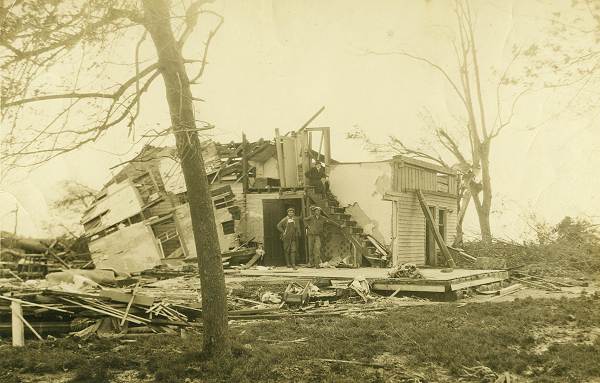
16 Eldon Tornado - 1927
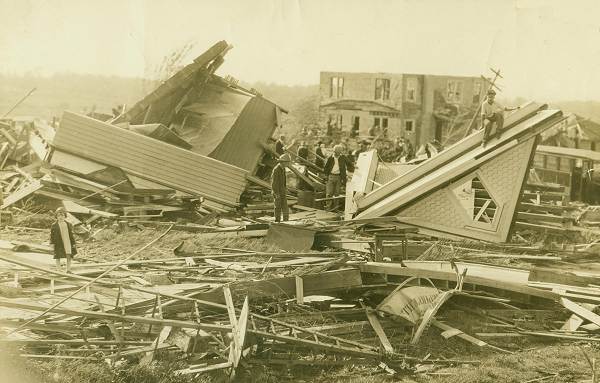
17 Eldon Tornado - 1927
Eldon Advertiser
May 12, 1927
Four Killed and Many Hurt As Tornadoes Swept Across Miller County Sunday Night.
Mrs. Charles Miller loses life while babe she held in arms escapes; body of Daniel Sidebottom, age three, found 150 yards from home; Score or more injured; livestock killed; property loss may mount to more than $100,000.
The northwest part of county was in the path of two cyclones which swept through Miller, Cole and Callaway Counties Sunday night and left death and destruction in their wake.
Miller County toll: The known dead are Mrs. Chas. Miller aged 35; Wes Bailey, aged 42; Danny Sidebottom, aged three; Mrs. Guy Nichols, aged 24. The injured are Mrs. Minnie Rea, seriously; Ad Scott; a daughter of George Hicks; Ralph Shackelford; Richard Garrett; Marvin Sidebottom, seriously; Lawrence Stewart; Mrs. Marvin Sidebottom; M. Shoemaker; Chas. Iuchs; Doris Lorraine Iuchs; Albert Gouge; Lafe Vaughan, Mrs. Lafe Vaughan; Marvin Sidebottom, Jr.
The path of the storm was in an almost northern course, about one mile west of Eldon and a half mile or so west of Olean.
Its intensity seems to have been the greatest about the Julius Cotten farm. Nothing was left there to show there had been a building except a conglomeration of lumber and slabs of concrete. Mr. and Mrs. Richard Garrett, who lived in the Cotten house, literally had the buildings blown from around them. After the storm passed over, they found themselves in the middle of the debris, severely cut and bruised about their face and bodies.
Three horses belonging to Sol Shoemaker were killed.
In the Olean vicinity possible the heaviest loser was Edgar Melton. His house and barn were blown away, as well as their contents.
It was reported that all his livestock was killed except a cow. Mr. and Mrs. Melton and family had taken refuge in the cellar which probably accounts for their escape.
Mrs. Guy Nichols and little son, three years old, were on the road north of Eldon and in the path of the storm when it struck. They were driving a Dodge Sedan which was blown over into a wheat field about three hundred yards from the road and when found, was standing upright with the top blown off. Mrs. Nichols was very seriously injured in the head and one leg badly mangled.
Mrs. Nichols passed away Tuesday evening and was buried Wednesday.
This spring we are experiencing the cyclical return of the noisy Cicada locust. I don’t know if this is the 13 year or 17 year cycle. Just about any forest around here has them now, and the noise is constant and loud, although it is so unwavering that you get to where you don’t pay much attention (photo 18).
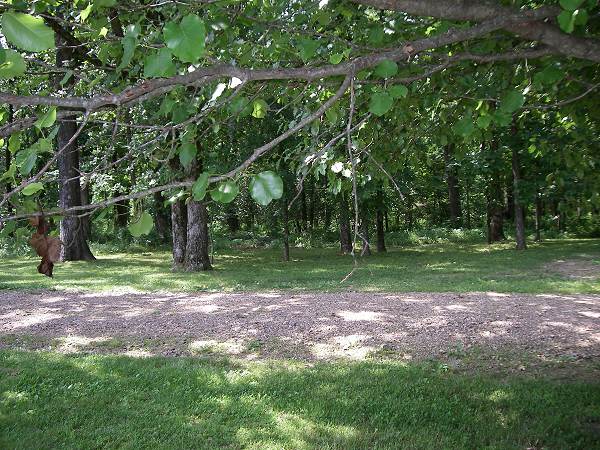
18 Woods full of Cicada
If your house is close to the woods and you have a window or door open, an occasional cicada may come in to visit you. In fact, one flew into the house of my wife’s sister, Sharon Holder, which I posed on my finger so you could see it (photos 19 - 22).
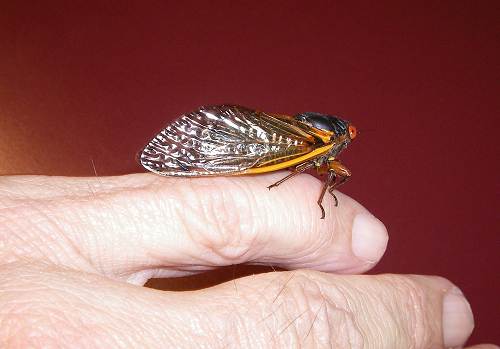
19 Cicada
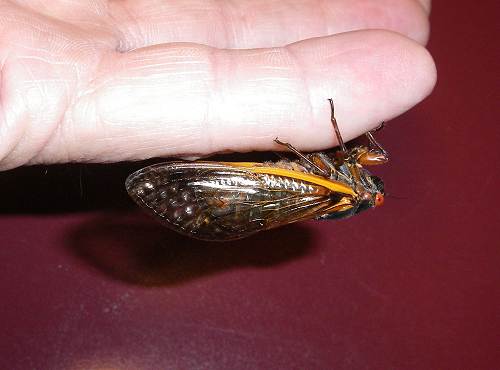
20 Cicada

21 Cicada

22 Cicada
While you are looking at the Cicada click on this website and listen to an MP3 recording of a Cicada locust.
If you want a scientific discussion of the Cicada, Wikipedia has it here.
Last Memorial Day weekend the Miller County Williams’ family descendents held their annual meeting at the Miller County Museum. About one hundred persons attended from many areas of the country (photo 23).
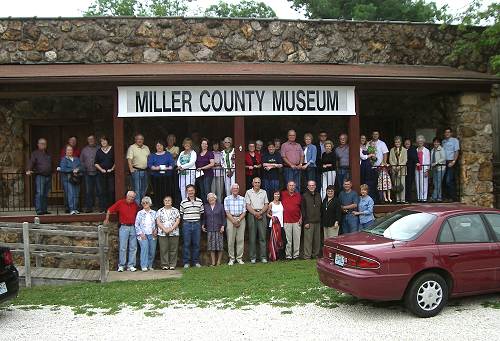
23 Williams Cemetery Meeting
Click image for larger view
The farthest away from here was Greta Pemberton of New York City. Interestingly, only one member of the group had a Williams surname, Bruce Williams of Iberia.
After the meeting many of the group travelled to the William’s Cemetery near Iberia to place memorial decorations. Here is a photo of the original John Williams tombstone, which barely can be read (photo 24).
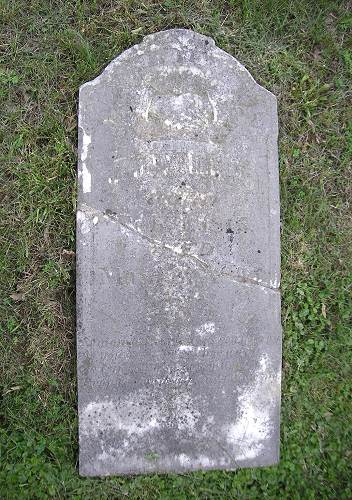
24 Original John Williams Jr. Tombstone
Click image for larger view
And here is a new tombstone recently obtained to replace the original (photos 25 and 26):
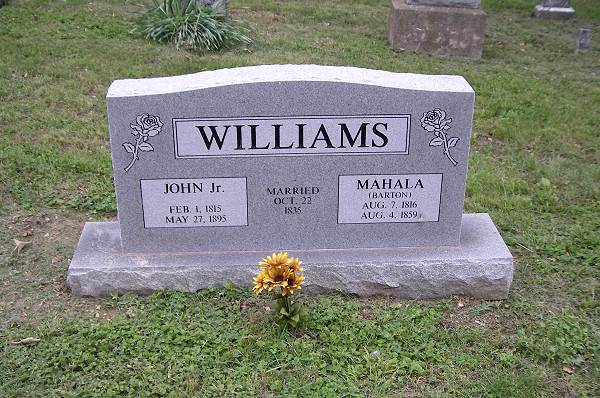
25 New John Williams Jr. Tombstone
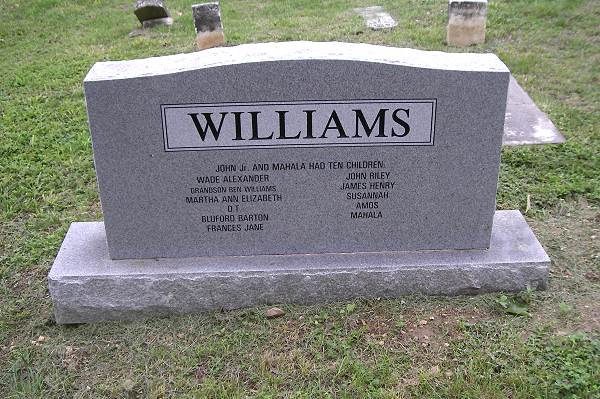
26 Reverse side of new John Williams Jr. Tombstone
You can read the fascinating story of John Williams Jr. at this location on our website.
If you take the time to read the story you will find out the origin of the smaller of the two cabins on our museum grounds.
Before the Williams family group left the museum to go to the cemetery, Don Pemberton, of Cape Girardeau, who was born and raised near Iberia on the Wade Pemberton farm more than ninety years ago, presented his autobiography as a means of describing to the younger attendees just how different life was in the early part of the last century (photo 27).
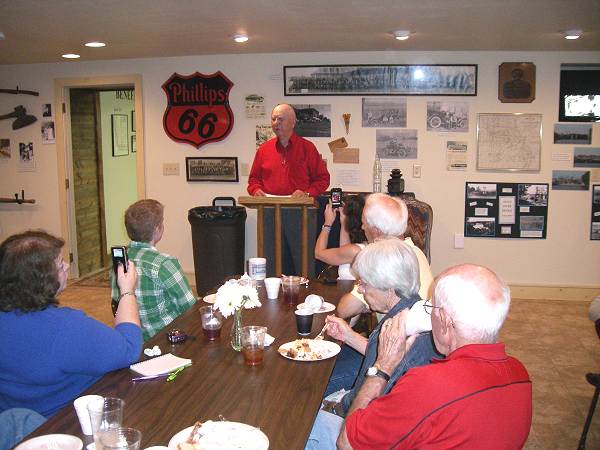
27 Don Pemberton
Don’s childhood home was only a short distance away from the original John William’s homestead and the William’s cemetery. I thought some of our readers might be interested in reading Don’s essay so I am presenting it here as an attachment (photo 28).

28 Don Pemberton Speech
Click image to read entire document in PDF format
Recently, our museum staff prepared a new display featuring the history of the making of the 20th Century Fox movie, “Glory Brigade,” part of which was shot on the Osage River just three miles west of Tuscumbia in 1952. We are grateful to former Eldon resident, Mike Wieneman for sending us original movie posters and photos having to do with the movie which among others starred Victor Mature and Lee Marvin. Mike also sent us a DVD of the original movie. We plan to have a showing of this movie in the near future. Mike had quite a large collection of memorabilia about the movie which he has sent us over the last year and now we are ready to display it to the public.
Here are some photos of the display we now have in place (photos 38 - 42):

38 Glory Brigade Display
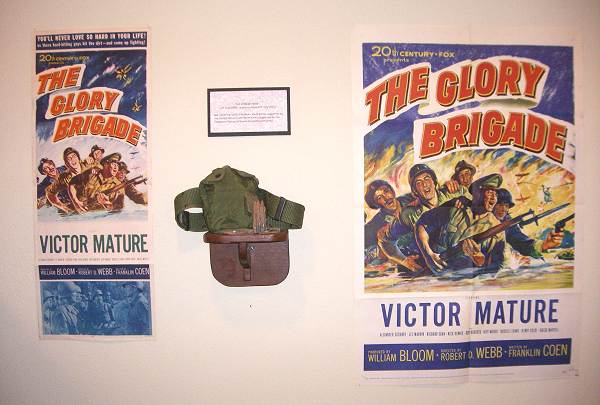
39 Glory Brigade Display
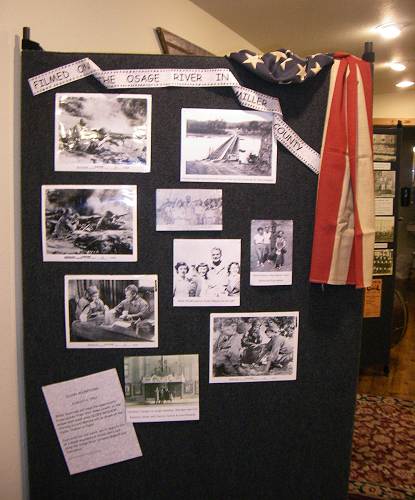
40 Glory Brigade Display
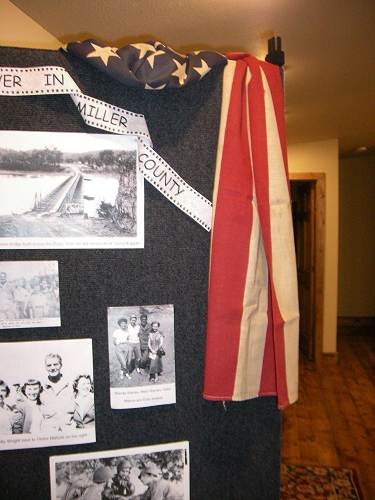
41 Glory Brigade Display
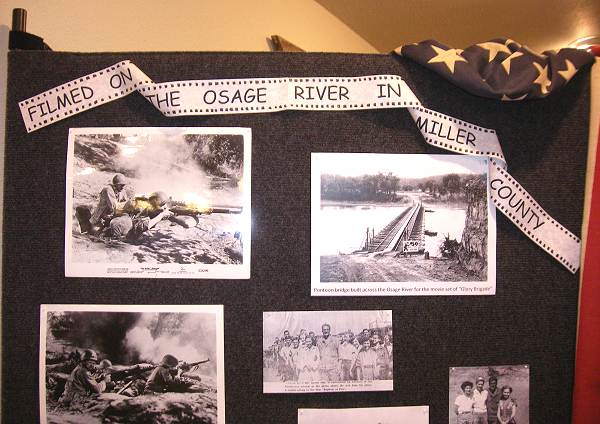
42 Glory Brigade Display
One of the most exciting moments of the movie was the explosion of the pontoon bridge built across the Osage River as part of the story of the escape of the American Soldiers from the advancing Korean Army.
The north end of the bridge was located on the Homer Lee Wright farm. Here is a photo of two of Glen’s daughters, Wanda and Mary Warren, posing with Victor Mature on his right and Eula Jenkins on his left (photo 44):
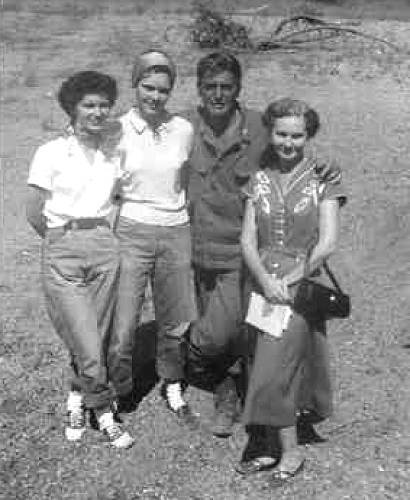
44 Wanda and Mary Warren and Eula Jenkins with Victor Mature
The movie “Glory Brigade” reached Miller County in mid August 1953 when it was shown at Tom Edwards Ozark Theater. Here is a copy of the newspaper movie advertisement from our display and a photo of the Ozark Theater (photos 46 and 47):
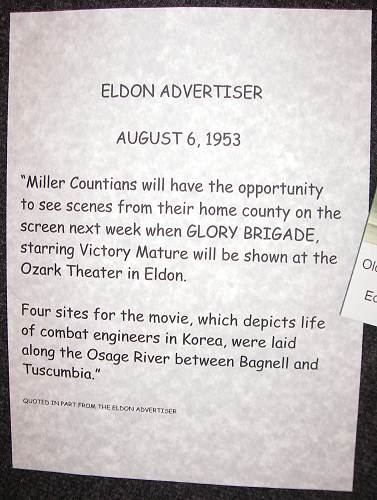
46 Newspaper Announcement
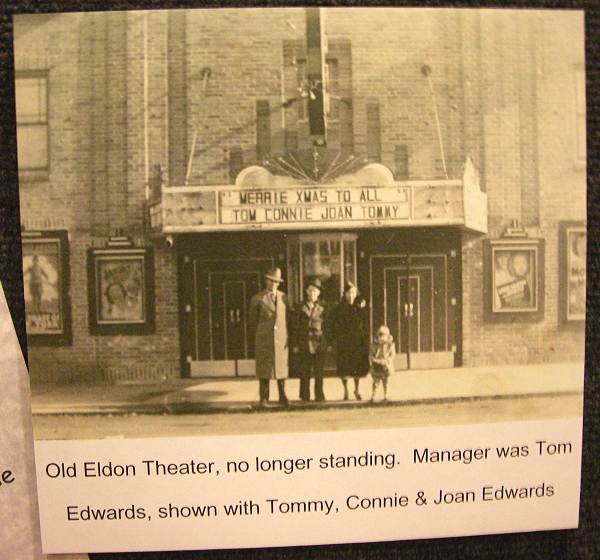
47 Ozark Theater
In addition to the movie memorabilia, Mike also sent a copy of an article saved by his mother from the August 6, 1953 Eldon Advertiser announcing the release of the movie to the public:
Eldon Advertiser
August 6, 1953
“Miller Countians will have the opportunity to see scenes from their home county on the screen next week when "Glory Brigade," starring Victor Mature, will be shown at the Ozark Theater in Eldon. The picture, filmed along the Osage River and in the Fort Leonard area, is scheduled for Tuesday, Wednesday and Thursday.
The 20th Century-Fox picture was originally announced as "Baptism of Fire" when the film was shot in Miller County last September. The name was changed before release.
Four sites for the movie, which depicts life of combat engineers in Korea, were laid along the Osage River between Bagnell and Tuscumbia. Most of the scenes were on the Homer Lee Wright farm up the river from Tuscumbia.
Fort Leonard Wood soldiers, who appeared in the movie, constructed a pontoon bridge from the Wright farm across the river to the Horton farm, and much of the action takes place around this bridge.
Other shots were taken on the Glen Warren Island, and around the Elmer Slone property.”
Mike also told us that some of the scenes of the movie were taken on property where his mother was born in 1915 on the Osage River road.
You can read a detailed discussion of the making of the movie, “Glory Brigade” and view many more of Mike’s photos at this previous Progress Notes.
Memorial Day which recently was celebrated brought as usual many visitors to our county and its cemeteries. The weather was good and almost all the cemeteries were replete with colorful memorial flower decorations. I took a photo at the north west corner of the Tuscumbia Cemetery which was highly decorated by many floral arrangements (photo 48).
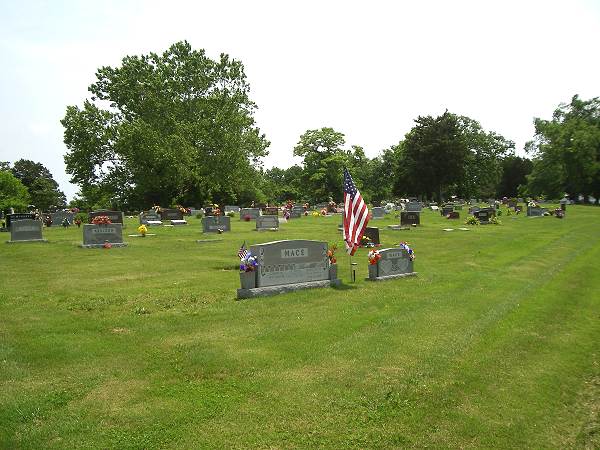
48 Tuscumbia Cemetery
Spring has been kind it seems to me for those who enjoy putting out flowers this time of year. My mother in law, Elvie Steen, who always has flowers inside and outside the home, had these colorful arrangements on tree stumps in her yard (photos 49, 50 and 51):

49 Red Petunias

50 Blue Petunias

51 White Petunias
The trees were cut years ago and the stumps have been there for many years. The home in which Elvie lives was built in 1907 by steamboat captain, John Adcock (photo 52).
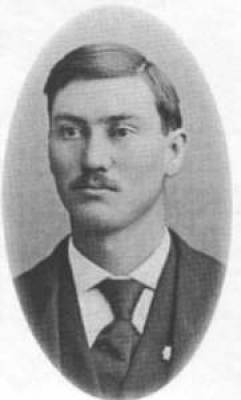
52 John W. Adcock
Here is a photo of the home more than a hundred years ago featuring John and his family (photo 53):
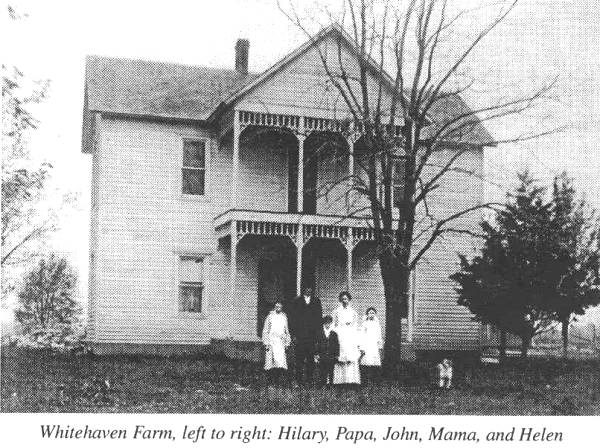
53 Adcock Home - 1909 in Flatwoods Area
And here is a photo of the home now (photo 54):
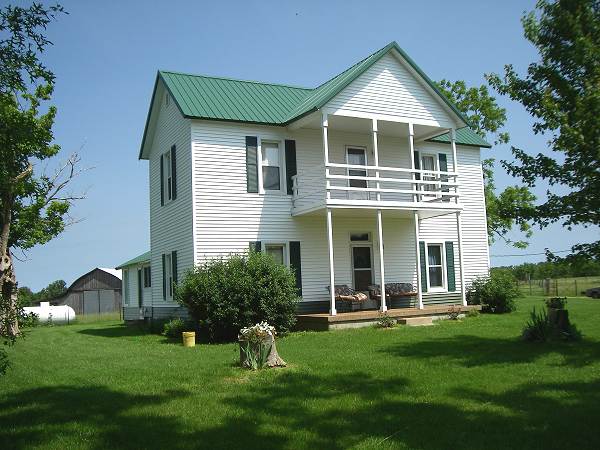
54 Elvie Steen Home - 2011
I can tell you that the home didn’t look this good last year after the hail storm which ruined the roof, broke most of the windows and tore up the siding.
John Adcock’s history is very interesting. You can read more about him at this previous Progress Notes.
That’s all for this week.
 Joe Pryor
Previous article links are in a dropdown menu at the top of all of the pages.
|

